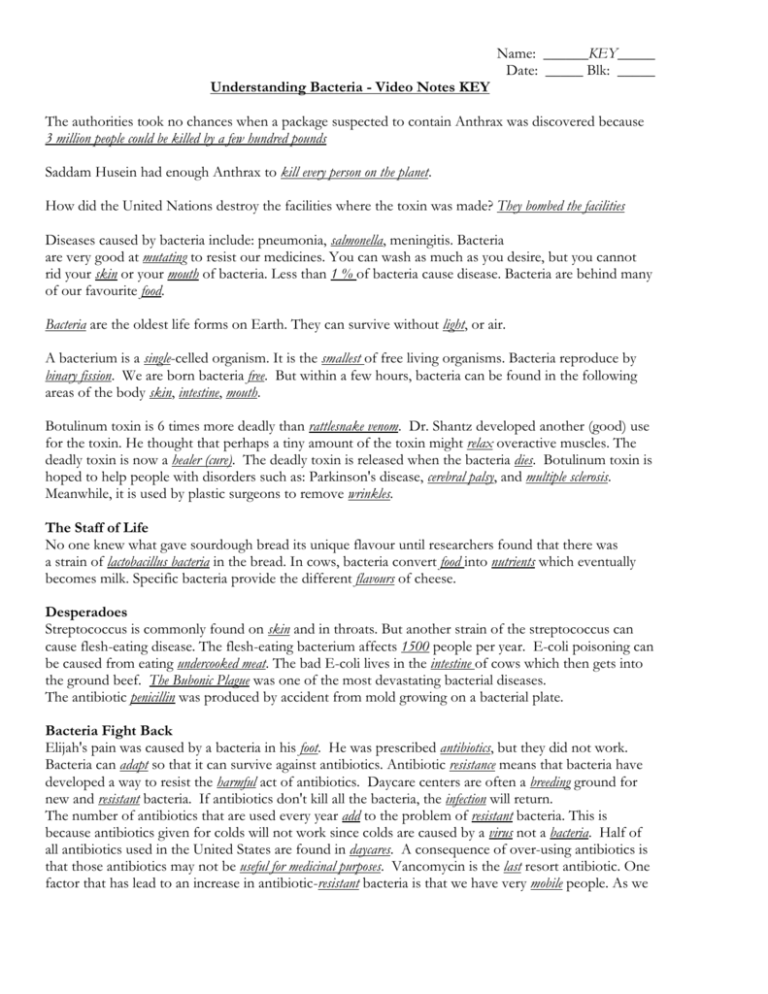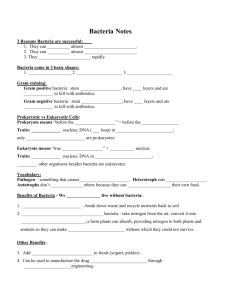Understanding Bacteria Video KEY
advertisement

Understanding Bacteria - Video Notes KEY Name: ______KEY_____ Date: _____ Blk: _____ The authorities took no chances when a package suspected to contain Anthrax was discovered because 3 million people could be killed by a few hundred pounds Saddam Husein had enough Anthrax to kill every person on the planet. How did the United Nations destroy the facilities where the toxin was made? They bombed the facilities Diseases caused by bacteria include: pneumonia, salmonella, meningitis. Bacteria are very good at mutating to resist our medicines. You can wash as much as you desire, but you cannot rid your skin or your mouth of bacteria. Less than 1 % of bacteria cause disease. Bacteria are behind many of our favourite food. Bacteria are the oldest life forms on Earth. They can survive without light, or air. A bacterium is a single-celled organism. It is the smallest of free living organisms. Bacteria reproduce by binary fission. We are born bacteria free. But within a few hours, bacteria can be found in the following areas of the body skin, intestine, mouth. Botulinum toxin is 6 times more deadly than rattlesnake venom. Dr. Shantz developed another (good) use for the toxin. He thought that perhaps a tiny amount of the toxin might relax overactive muscles. The deadly toxin is now a healer (cure). The deadly toxin is released when the bacteria dies. Botulinum toxin is hoped to help people with disorders such as: Parkinson's disease, cerebral palsy, and multiple sclerosis. Meanwhile, it is used by plastic surgeons to remove wrinkles. The Staff of Life No one knew what gave sourdough bread its unique flavour until researchers found that there was a strain of lactobacillus bacteria in the bread. In cows, bacteria convert food into nutrients which eventually becomes milk. Specific bacteria provide the different flavours of cheese. Desperadoes Streptococcus is commonly found on skin and in throats. But another strain of the streptococcus can cause flesh-eating disease. The flesh-eating bacterium affects 1500 people per year. E-coli poisoning can be caused from eating undercooked meat. The bad E-coli lives in the intestine of cows which then gets into the ground beef. The Bubonic Plague was one of the most devastating bacterial diseases. The antibiotic penicillin was produced by accident from mold growing on a bacterial plate. Bacteria Fight Back Elijah's pain was caused by a bacteria in his foot. He was prescribed antibiotics, but they did not work. Bacteria can adapt so that it can survive against antibiotics. Antibiotic resistance means that bacteria have developed a way to resist the harmful act of antibiotics. Daycare centers are often a breeding ground for new and resistant bacteria. If antibiotics don't kill all the bacteria, the infection will return. The number of antibiotics that are used every year add to the problem of resistant bacteria. This is because antibiotics given for colds will not work since colds are caused by a virus not a bacteria. Half of all antibiotics used in the United States are found in daycares. A consequence of over-using antibiotics is that those antibiotics may not be useful for medicinal purposes. Vancomycin is the last resort antibiotic. One factor that has lead to an increase in antibiotic-resistant bacteria is that we have very mobile people. As we travel we can transmit a resistant organism from one continent to another. Gold Bug Bacteria can tolerate cyanide. Researchers found that bacteria used cyanide as a food source. All the water is filtered through tanks containing bacteria (pseudomonas) which cleans the cyanide out of the water. A Little Good News H. pilori thrives in the stomach and causes ulcer a patient needs to take antibiotics between bacteria and many chronic illnesses like asthma, colitis and causes cancers. Learning the Alphabet Once the genetic blueprints of the microorganisms are completed, the functions of the genes are studied. Bacterial chromosomes are very highly evolved In order for a microbe to be able to eat something in its environment the bacteria need to be able to produce a specific enzyme. Most antibiotics come from bacteria living in the soil. The experts say this is the "golden-age" of microbiology.









